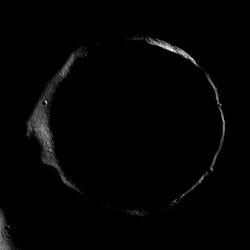Astronomy:Crater of eternal darkness

A crater of eternal darkness is a depression on a body in the Solar System within which lies a point that is always in darkness.
A related term is permanently shadowed regions.[1][2] As of 2019, there are 324 known permanently shadowed regions on the Moon.[3]
Location
Such a crater must be located at high latitude (close to a pole) and be on a body with very small axial tilt.
On the Moon, permanent shadow can exist at latitudes as low as 58°; approximately 50 permanently shadowed regions exist in the 58°- 65° latitude range for both lunar hemispheres.[4]
Conditions inside craters
Craters of eternal darkness might be advantageous for space exploration and colonization, as they could potentially preserve sources of water ice. For example, Rozhdestvenskiy crater shows indirect indications of water ice in its interior.[5]
In some cases, peaks of eternal light are located nearby, that could be advantageous for solar power generation. For example, there are 2 peaks near Shackleton Crater that are illuminated a combined ~94% of a lunar year.[6]
Permanently shadowed regions have a stable surface temperature. On the Moon, the temperature hovers somewhere at or below 50 degrees Kelvin.[7] Another temperatures estimate is 25 K to 70 K.[8] On the other hand, computer simulations show that powerful solar storms can charge up the soil in permanently shadowed regions near the lunar poles, and may possibly produce "sparks" that could vaporize and melt the soil[9][10].
List

Below is an incomplete list of such craters:
The Moon:
Mercury:
- Petronius crater[15]
Many such craters also exist on Ceres.[16]
Future missions
Lunar Flashlight is planned to launch in 2021 as a secondary payload for the Artemis 1 mission.[17][18]
A camera called ShadowCam is being built that will be able to take high-resolution images of Permanently Shadowed Regions. It is a NASA instrument that will fly on board the Korea Pathfinder Lunar Orbiter (KPLO) in 2022.[19]
See also
References
- ↑ https://lunar.gsfc.nasa.gov/images/lithos/LRO%20litho5-shadowedFinal.pdf
- ↑ https://svs.gsfc.nasa.gov/11218
- ↑ http://lroc.sese.asu.edu/psr/list
- ↑ https://meetingorganizer.copernicus.org/EPSC2012/EPSC2012-756.pdf
- ↑ Mitchell, Julie (2017). Investigations of Water-Bearing Environments on the Moon and Mars. Bibcode: 2017PhDT.......229M.
- ↑ Bussey D. B. J., McGovern J. A., Spudis P. D., Neish C. D., Noda H., Ishihara Y., Sørensen S.-A. (2010). "Illumination conditions of the south pole of the Moon derived using Kaguya topography". Icarus 208 (2): 558–564. doi:10.1016/j.icarus.2010.03.028. Bibcode: 2010Icar..208..558B.
- ↑ http://lroc.sese.asu.edu/posts/96
- ↑ http://lroc.sese.asu.edu/posts/979
- ↑ http://thescienceexplorer.com/universe/solar-storms-could-spark-soils-moons-poles
- ↑ https://www.semanticscholar.org/paper/Deep-dielectric-charging-of-regolith-within-the-Jordan-Stubbs/435f72e106b79692c11c71aba998c96638f3ff39
- ↑ http://lroc.sese.asu.edu/posts/96
- ↑ http://lroc.sese.asu.edu/posts/979
- ↑ Sanin, A. B.; Mitrofanov, I. G.; Litvak, M. L.; Malakhov, A.; Boynton, W. V.; Chin, G.; Droege, G.; Evans, L. G. et al. (2012). "Testing lunar permanently shadowed regions for water ice: LEND results from LRO". Journal of Geophysical Research: Planets 117: n/a. doi:10.1029/2011JE003971.
- ↑ Sanin, A. B.; Mitrofanov, I. G.; Litvak, M. L.; Malakhov, A.; Boynton, W. V.; Chin, G.; Droege, G.; Evans, L. G. et al. (2012). "Testing lunar permanently shadowed regions for water ice: LEND results from LRO". Journal of Geophysical Research: Planets 117: n/a. doi:10.1029/2011JE003971.
- ↑ https://www.nasa.gov/mission_pages/messenger/multimedia/messenger_orbit_image20121015_1.html
- ↑ Schorghofer, Norbert; Mazarico, Erwan; Platz, Thomas; Preusker, Frank; Schröder, Stefan E.; Raymond, Carol A.; Russell, Christopher T. (2016). "The permanently shadowed regions of dwarf planet Ceres". Geophysical Research Letters 43 (13): 6783–6789. doi:10.1002/2016GL069368.
- ↑ https://www.space.com/27388-nasa-moon-mining-missions-water.html
- ↑ https://arstechnica.com/science/2019/07/nasas-large-sls-rocket-unlikely-to-fly-before-at-least-late-2021/
- ↑ http://lroc.sese.asu.edu/posts/979
External links
- Permanently Shadowed Regions Atlas
- Eternal Darkness Near the North Pole
- Eternal Darkness of Petronius Crater

